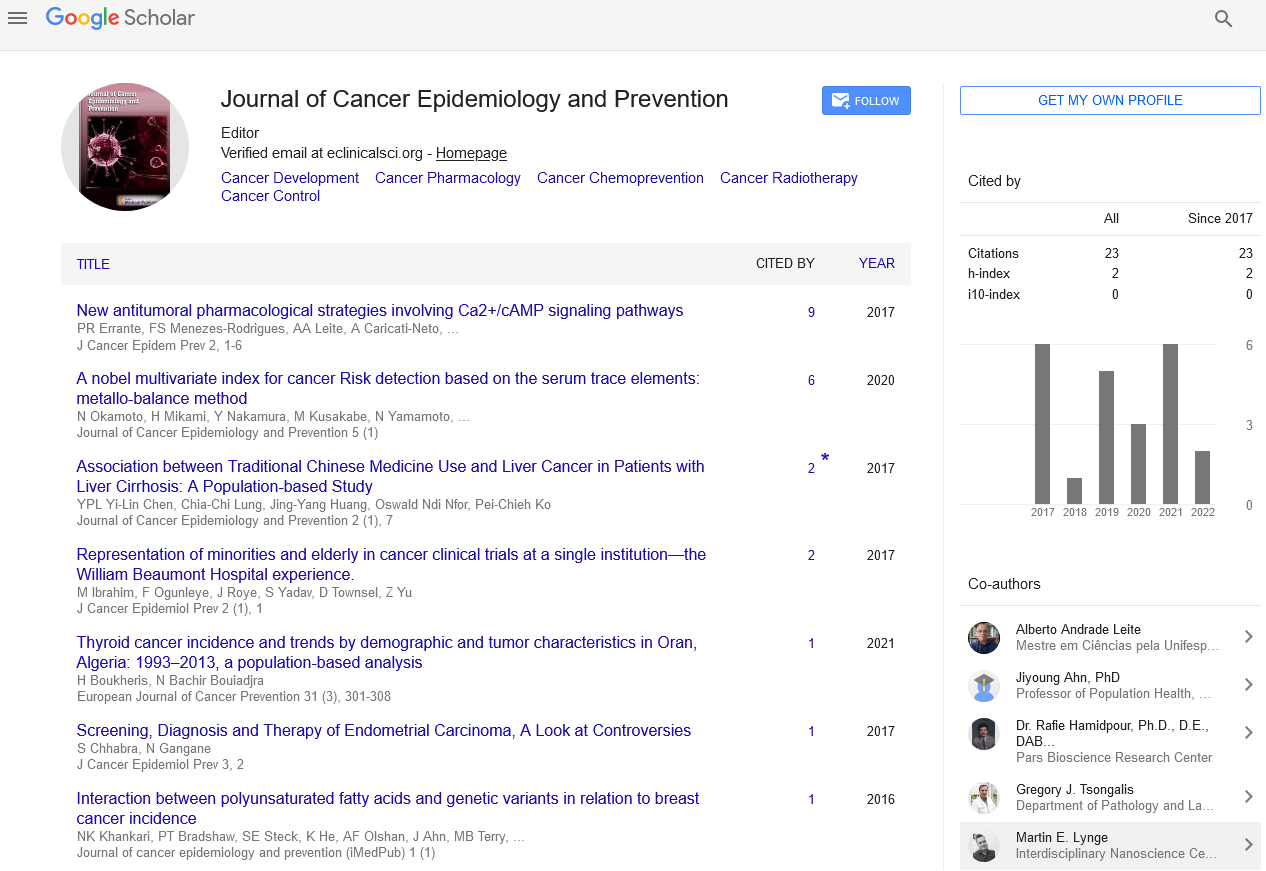Commentary - (2024) Volume 9, Issue 2
Understanding Cancer Genetics: Unravelling the Complexity of Tumorigenesis
Tom Kiesche*
Department of Ecosystem Science, Lund University, Sweden
*Correspondence:
Tom Kiesche,
Department of Ecosystem Science, Lund University,
Sweden,
Email:
Received: 29-May-2024, Manuscript No. IPJCEP-24-20850;
Editor assigned: 31-May-2024, Pre QC No. IPJCEP-24-20850 (PQ);
Reviewed: 14-Jun-2024, QC No. IPJCEP-24-20850;
Revised: 19-Jun-2024, Manuscript No. IPJCEP-24-20850 (R);
Published:
26-Jun-2024, DOI: 10.36648/IPJCEP.9.2.18
Introduction
Cancer remains one of the most challenging health concerns
of our time, affecting millions of lives worldwide each year.
Despite advances in treatment and early detection, the intricate
mechanisms underlying cancer development continue to
elude complete understanding. In recent decades, however,
significant strides have been made in the field of cancer genetics,
illuminating the genetic basis of various cancers and paving
the way for targeted therapies and personalized medicine
approaches. This article delves into the complexities of cancer
genetics, exploring the role of genetic mutations, oncogenes,
tumour suppressor genes, and the promise of genomic medicine
in the ongoing battle against cancer. Cancer arises from the
uncontrolled growth and proliferation of cells, often triggered
by genetic alterations that disrupt normal cellular functions.
These alterations can be inherited (germline mutations) or
acquired (somatic mutations) during an individual’s lifetime
due to environmental factors or spontaneous errors in DNA
replication. Central to cancer genetics are oncogenes and
tumour suppressor genes, which play opposing roles in
regulating cell growth and division: Normally, proto-oncogenes
regulate cell growth and differentiation. When mutated or
activated, they become oncogenes, promoting uncontrolled
cell division and tumour formation. Examples include HER2 in
breast cancer and BRAF in melanoma. These genes normally
inhibit cell division, repair DNA damage, and promote apoptosis
(programmed cell death).
Description
Mutations that inactivate tumour suppressor genes, such as TP53
(p53), BRCA1, and BRCA2, can lead to unchecked cell growth
and cancer development. Genetic mutations are fundamental
in driving cancer initiation and progression. These mutations
can occur in various genes involved in critical cellular processes.
Mutations impairing DNA repair mechanisms (e.g., BRCA1/2)
increase susceptibility to cancer, as damaged DNA accumulates,
leading to further mutations and genomic instability. Alterations
in genes controlling the cell cycle (e.g., cyclin-dependent
kinases) can disrupt the orderly progression from one phase of
the cell cycle to the next, promoting uncontrolled cell division.
Some cancers have a strong hereditary component, where
specific gene mutations increase the likelihood of developing
certain types of cancer. Mutations in DNA mismatch repair
genes (MLH1, MSH2, etc.) predispose individuals to colorectal
and other cancers. Mutations in BRCA1 and BRCA2 significantly
increase the risk of breast, ovarian, and other cancers. Recent
advancements in genomic sequencing have revolutionized
cancer research and clinical practice.
Conclusion
The era of precision medicine has emerged from our growing
understanding of cancer genetics. By identifying specific genetic
alterations driving individual tumours, targeted therapies can
be developed to selectively inhibit oncogenic pathways. Target
mutations in kinases involved in cell signalling pathways,
such as EGFR inhibitors in lung cancer (e.g., gefitinib). Exploit
deficiencies in DNA repair pathways (e.g., BRCA mutations)
to selectively kill cancer cells, as seen in ovarian and breast
cancers. Immunotherapy has revolutionized cancer treatment
by harnessing the body’s immune system to target cancer
cells. Cancer genomics plays a crucial role in predicting patient
response to immunotherapy. High TMB correlates with
increased response to immune checkpoint inhibitors (e.g.,
PD-1/PD-L1 inhibitors) across various cancer types.
Acknowledgement
None.
Conflict Of Interest
The author’s declared that they have no conflict of interest.
Citation: Kiesche T (2024) Understanding Cancer Genetics: Unravelling the Complexity of Tumorigenesis. J Cancer Epidemiol Prev. 9:18.
Copyright: © 2024 Kiesche T. This is an open-access article distributed under the terms of the Creative Commons Attribution License, which permits unrestricted use, distribution, and reproduction in any medium, provided the original author and source are credited.

